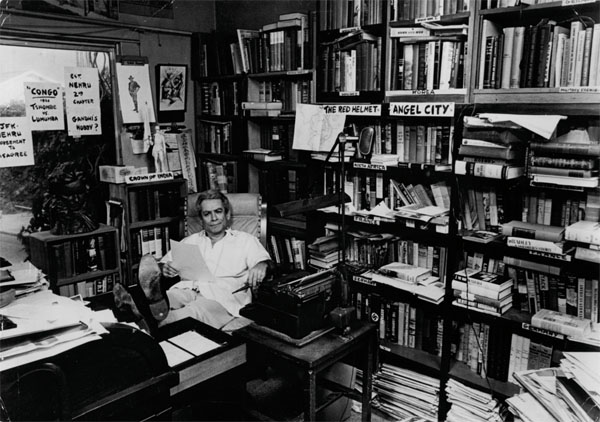“Checking my appointment book for 1980,” wrote Jonathan Rosenbaum in 2003, “I see that I met Sam Fuller for the first time on June 19, in New York. It was in a suite at the Plaza, where I went to interview him about The Big Red One for the Soho News, and from the moment a publicist opened the door and I was greeted by this short, peppy firecracker, he was already outlining a movie sequence in which I was being kidnapped by a team of Amazons, with the publicist instantly cast as one of the members of the team.” So begins a review of Fuller’s autobiography, A Fuller Life, re-released in 2002 as A Third Face: My Tale of Writing, Fighting, and Filmmaking; the review is also, of course, a lively survey of the oeuvre.
“Even before he became an influential, uncompromising filmmaker, he was a freelance reporter during the Great Depression and a member of the 16th Infantry Regiment, 1st Infantry Division during World War II,” wrote Susan King in the Los Angeles Times last month. “During his career, he directed such seminal war films as 1951’s The Steel Helmet, 1957’s China Gate, 1962’s Merrill’s Marauders and 1980’s The Big Red One, which was based on his own experiences in the global conflict. Other classics in the Fuller canon include 1957’s Forty Guns, 1963’s Shock Corridor and 1964’s The Naked Kiss.”
“A truly unique career is lovingly celebrated in A Fuller Life, director Samantha Fuller’s heartfelt tribute to her legendary father,” writes Neil Young in the Hollywood Reporter. “Featuring extended extracts from Sam Fuller’s own 2003 autobiography, read by a slew of collaborators and celebrity admirers, the film takes a relaxed approach to a life full of excitement, chaos and conflict…. The speakers start with the currently inescapable James Franco, and include actors Mark Hamill and Robert Carradine (from The Big Red One), Tim Roth, Jennifer Beals and Constance Towers (from 1964’s The Naked Kiss), these ladies offering welcome respite from what is occasionally a testosterone-soaked affair. Later sections feature directors Joe Dante, Wim Wenders, Monte Hellman, and William Friedkin, each of them reading from Fuller’s manuscript in the claustrophobically cozy confines of the author’s own fabled, paraphernalia-stuffed den-cum-study.”
“Their readings play out over a mix of archive footage, clips from his work, rostrum camera stills and, most interestingly, home movies shot by Fuller himself, including some of his wartime experiences,” notes Oliver Lyttelton at the Playlist. “His childhood work as a newsboy and subsequent career as a crime writer are dealt with fairly briskly but the bulk of the film, and the best material, deals with his time in the Second World War. This was where he was involved in the D-Day landings, had a hilarious and touching encounter at a USO show with Marlene Dietrich and helped liberate a concentration camp, both of which can be glimpsed in footage shot by Fuller.” All in all, A Fuller Life “essentially comes across as a star-studded audiobook…. Perhaps more importantly, the film works very well as a daughter’s tribute to her father as a man, and that seems to be exactly what it set out to be.”
“In 1951, Fuller had the scoop on the Korean War with The Steel Helmet,” writes J. Hoberman in the Los Angeles Times. “With Shock Corridor, released 50 years ago this month, the former crime reporter had the scoop on the ’60s. Conceived and produced during the run-up to America’s decade-long season of domestic violence, Shock Corridor is the movie in which the hard rain first began to fall, accompanied by electrode-induced thunder and lightning, to flood the mental hospital in which it is set.”
A little over a week ago, Hoberman revisited Shark (1969) aka Caine aka Man-Eater, “the first movie that Samuel Fuller made after the slap in the face that was The Naked Kiss effectively terminated his Hollywood career. It was shot in Manzanillo, Mexico during the Summer of Love and returns to us now courtesy of the intrepid catalog scroungers of Olive Films.” Shark “is full of Fullerian tropes and trademarks (the obligatory five-year-old mascot, the bizarre tertiary characters, the showboat cynicism as when a newly bereaved mother stoically accepts her blood money and then counts the bills like a stoolie receiving a pay-off). The performances are professional, not least Arthur Kennedy’s cheerful hamming as the requisite drunken doctor.” And “the denouement… is uncompromising… but only if you know that, as Fuller writes in his memoir, he conceived it as a tribute to Erich von Stroheim’s Greed.”
A Fuller Life screened as part of this year’s Venice Classics program.
Venice 2013 Index. For news and tips throughout the day every day, follow @KeyframeDaily on Twitter and/or the RSS feed. Get Keyframe Daily in your inbox by signing in at fandor.com/daily.





